Mailing lists as part of customer service
Disclaimer in small letters: the author understands the painfulness of the topic of mass mailings. The article is written for a professional reader who considers e-mail an ethical means of communicating business with a client, but realizes that the topic is littered with “effective marketers” (they are spammers), and therefore extremely cautious in their gestures in the e-mail marketing area.
Why are some letters perceived by clients as spam, and others as useful reminders? What should be letters to help people buy? Which errors of mailing lists as a customer service are excusable, and which ones are fatal? Let's look at the cases and discuss the pros and cons of solutions.
Over the past few years, even the most highly motivated Internet businesses have moved from the policy “We will never send letters to our customers” to much calmer wording. Send as pretty - all or almost all.
From an economic point of view, this (for the time being) is beneficial to almost everyone: click on the button - send a text - get an increase in sales. Someone knows more "chips" - and counts the gold after each mailing. Someone figs as it may at random - but also usually does not mean nothing.
')
But harsh business laws cannot be fooled: if money comes out almost from the air (for now it is still like that), it means that some irreplaceable resource is being exploited in the process of being airborne.
What kind of resource is it, to whom does it belong, and is it worth exploiting it blindly?
There is an assumption (which is considered in this article) that this irreplaceable and mercilessly exploited resource is the emotional balance of users. Their gullibility and even naivety. Their readiness for communications. Their focus of attention. Their agreement to consume and digest information that catches the eye.
By itself, the exploitation of this resource is not such a black deed. This is known by whole crowds of offline personalities, from hitchhikers to MLM-traders in cosmetics, from sellers of newspapers in electric trains to street musicians.
Somewhere in this series are not too solid, but it’s not that shameful activities are worth e-mail marketing. And, as in all the above classes, in e-mail marketing, much depends on the mood in which a person comes in contact with you - and in which of them he leaves.
Managing customer emotions is part of customer service. So, when working with clients via e-mail, it would be good to know the rules for providing good service. Ideally, it would be nice to use them too.
It would seem that here it is time for us to move on to a conversation about "chips" and "receivers" that will help to position the user to us. Make a pink background in the letter - and immediately the girls melt, something like that.
But no, the notorious "chips" will not. First of all, the entire Internet is already full of them. Secondly, even the best “tricks” will only give the addressee a disservice if you don’t understand the main thing. And, thirdly, the core of your e-mail marketing would be, and the "tricks" are already easy to attach.
Let's focus on the main thing. Namely - on the problem that each of us deals with daily. And as a pro, and as a private person. Here it is, this problem:
Suppose you are writing an honest and open letter to a narrow group of your customers, inviting them to a free party with oysters and champagne - but they do not believe you. But you really conceived such a party! Something went wrong ... What?
Let's figure it out.
If you ask people what letters they consider spam, then we will hear something like the following:
Perhaps the list can and continue. But let's stop on this for now. We breathe. Exhale And we understand that in this particular case, a person speaks not about objective reality, but about his emotions. Which means he's damn right!
Once again and slowly: the client has the right to emotions. And if he has already shown them - it means that one of the triggers of the negative reaction worked.
Well, impressive? And now all this together - and the beggins, in front of us is a hefty such Dnieper, which not every bird will fly over.
Interestingly, the emotional evaluation of the letter occurs instantly. Perhaps in a split second. Only autistic engineers are trying to subtract and understand something there - normal people just explode with emotion and sentence your letter, and at the same time you are given a life ban.
Do you think about “chips” here?
We will conduct an experiment on living people - let's see what letters they, in fact, receive. Of course, we are only interested in mass and / or automatic mailings, and not personal correspondence.
Naturally, the average temperature in the hospital is rather difficult to calculate. To whom how much correspondence comes - it is a very individual matter.
However, to emotionally evaluate this correspondence, on the contrary, is quite easy. One has only to look from the point of view of the recipient - and everything becomes clear.
The fact is that with each individual letter the recipient must act in a certain way. These images, strictly speaking, are two.
That's all. Now or later. Yes, this is so simple.
And now there will be an ambush.
Which option do you think people usually prefer?
Yes, it was a trick question. Yes, it seems that all people are different and all have their own preferences. Yes, it all depends — it would seem — on the content of the letter. But no.
Sociologists have tormented and tormented and proved an interesting law, which (in a simplified, of course, variant) sounds like this:
That is, you know what a thing, any - any! - the letter puts the person in a situation where he would prefer that this letter was not. No letter - no need to make a decision. In spam, in the basket, anywhere - the recipient is struggling with the fact of the existence of the letter, and not with its content. Many simply do not read mail - scary.
Yes, it seems like a small thing. But it seems to us so. For people who spend 5–10 minutes only to enter their mailbox, each letter twists its arms. And making a decision for them is painfully difficult.
And for people, on whom letters are falling hundreds per day, on the contrary, it is painfully easy to press the “In Spam” button. Just give a reason.
Look, we have already found out that everyone is absolutely everyone! - the letter is subject to the presumption of guilt. Either prove that you are a little dear, worthy of a decision on your case - either die, miserable, not callous eyes.
Let's classify the entire flow of what we have already seen in the Inbox. Exclusively from the point of view of the user and his interests. Different options are possible here, but we will limit ourselves to the classical 2x2 matrix and isolate 4 types of mass mailings.
That's all. It looks pretty simple too, right? Wait, everything is just beginning.
Scatter these four types on a 2x2 matrix and see what happens.

Vertically - the axis of engagement: whether the user remembers the context, tries to do something in connection with the main topic of the letter, is ready to act right now.
Horizontal is the axis of speed: how fast is the user ready to act.
It doesn't get any simpler, but I remind you that our goal is to roll over (along with the recipient of the letter) beyond the emotional threshold “Yes, go to hell with your spam!”.
And to smooth this threshold, you can, in fact, only in one way: send letters that the user recognizes and perceives as simplifying (and not complicating) the decision.
But user decisions are laid out in the same 2x2 matrix: do I want to do something and am I ready to do it right now. For the same matrix!
Wait, so what's coming out? A simple thing comes out: if the user is in the same state that the letter relies on, then the letter is perceived not as spam, but as a service! As part of the service. Like a hint. Like a cheat sheet. As a crutch when making a decision. In short, as a useful thing.
And let's face it again. Simple and understandable truth.
When we looked at the inbox ...
Stop, after all you considered it too? Half a thousand letters will be enough to figure it out on your own. Do not be lazy, please, but it will turn out that you believe me on the word where it suits.
So, when we looked at the Inbox, we classified the letters from the user's point of view. And this is not at all the same as classifying them from the point of view of the sender.
It is clear that senders, consciously or intuitively, seek to mask one type of letters under another - from their point of view, it is easier to pass an emotional spam threshold. But as a result of this attempt to “cut off the corner” both the business and the clients receive such a bouquet from deception, self-deception and manipulation, from which the threshold only catastrophically increases.
We formulate it easier:
Masking one type of letters under another increases the spam threshold for a particular letter (and reduces the service-orientation of the business as a whole). That is why, by the way, decent companies are very, very cautious with mass mailings: in the event of an error, a blow hits not the letter, but the brand.
It is clear that a service-oriented company is simply forced to take care not to disguise information letters as service ones, and service ones - under pushing ones. And it certainly can’t undergo all pure masks under all “decent” masks.
Now analyze all kinds of camouflage. And we will understand how dangerous they are - or, on the contrary, are forgivable.

This shift usually happens with conference organizers. A completely normal story, if not for one “but”: mailing lists under the guise of information are usually written in a hurry, and they are often full of unpleasant errors.

If you got involved in this venture, first instruct the corrector to read the letter, and only then send it. Take your time, otherwise you will have time.
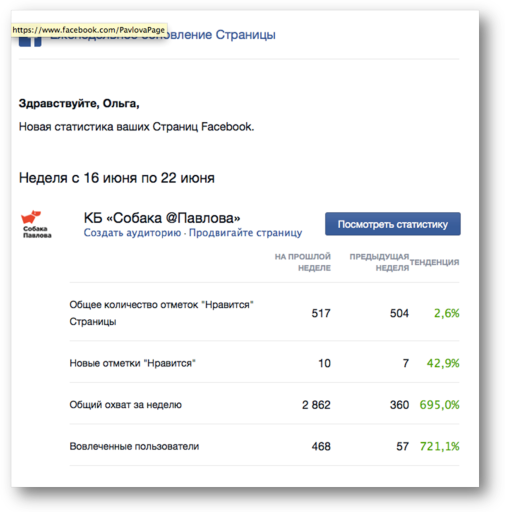
The easiest way to turn a service list into a push list is to send a statistical report. There is nothing bad, a normal move, but some may be frightened (numbers generally frighten people, especially if it is easy to see through them the quality — or “quality” —- their work).

Of course, the same people mastered the method the best, who knows a lot about gamification. Rush to do something right now to improve the performance of your favorite toys - a terrible force.

“Fly Alfa Bank airplanes!” I will fly, thank you. But, in general, I can’t take any concrete actions right now, no matter how I want Alfa-Bank and even myself.
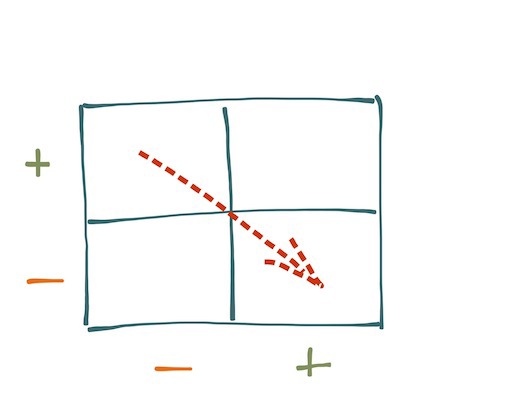
Attempting to make a push out of an information letter usually looks pathetic. It is here that all the authors of the "selling texts" and other urban madmen graze. It is in these ezines cool brands lose their gloss and self-esteem. The reason is clear: marketers are not used to waiting; they urgently need to get beautiful numbers for a report. Unpleasant mistake.
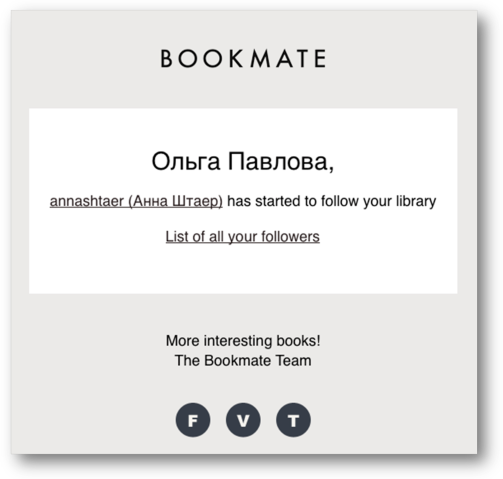
Nice try, Bookmate. And I would even believe that this is a service list, but the trouble is that all other work with friends is disgusting. That is, I don’t have any benefit from this message - only Bookmate himself benefits from the follow your library.
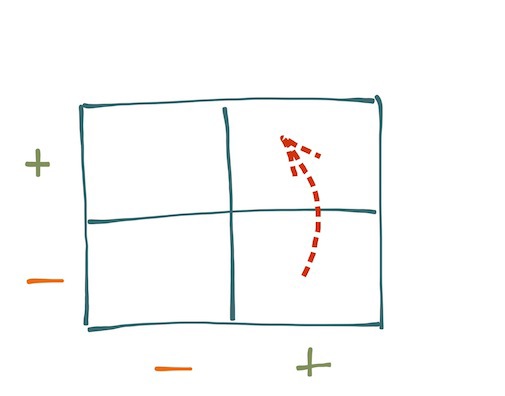
A rather unpleasant phenomenon. It is only softening that usually you can still unsubscribe from such pseudo-service letters.
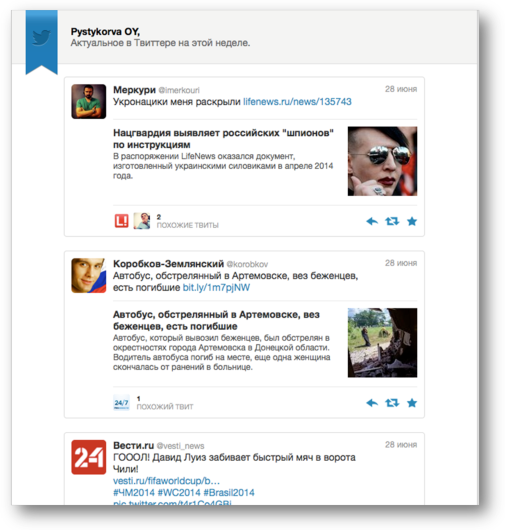
Twitter pretends to send a summary of recent events and interesting posts. In fact, of course, he is trying with all his might to translate a passive user into an active one.
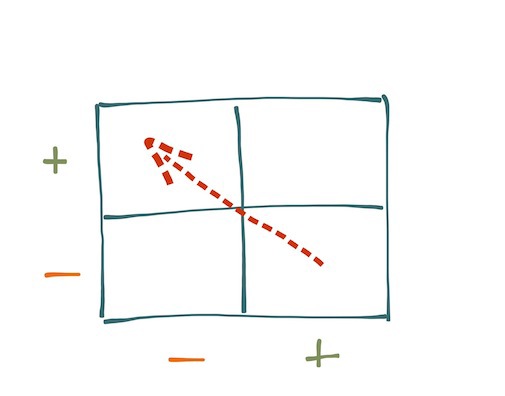
The method itself is more than OK, but there is a danger of overdoing it. Every day to send this - just a little bust.
Are there any hybrids without a dominant? Yes, easily.
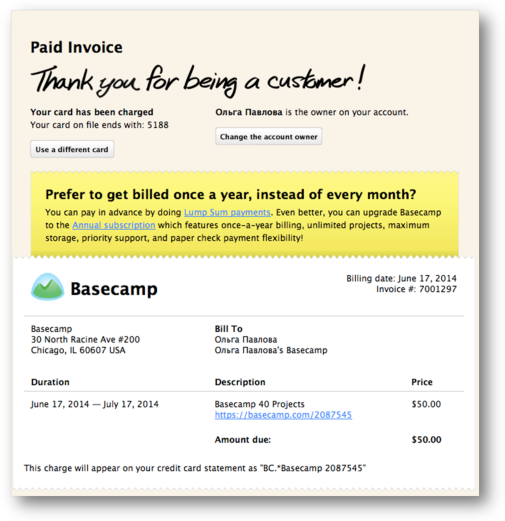
The idea, along with the message of official information, to sell something to a knowingly loyal customer comes to mind. In general, there is almost no trouble in this, if it were not for one “but”: usually the question “What to offer?” Is relegated to artificial reason. And he is glad to try to offer a bearded admin a bikini swimsuit - simply because a year ago he bought something similar to his (former) wife.
So here is more accurate with the implementation. And of course, the service information should be clearly separated from the advertising (yes, we all love Rostelecom’s account stuffed with advertising, but this is already an offline story).
Belief in the effectiveness of hybrids is indestructible. But in reality, it is most likely a myth and self-deception - it is almost unbearably difficult for the recipient to do two actions. However, you need to investigate the issue.
Pure spam is, in general, imposed communication. The user passed by, did not want anything, did not betray anything - and suddenly they made you happy.
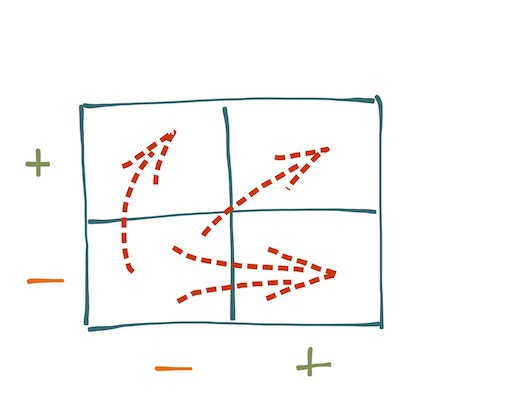
It is clear that spam is trying to disguise itself as any of the three “white” types of letters. But for me, by the way, it was a surprise that mostly spam mimics under pushing letters.
Which, by the way, is the most disgusting of all the options: pushing letters rely on some remaining off-screen context and continue the conversation with the user. And to continue the conversation, which was not, is either a manipulation (the question “Buy?” Is replaced by “Buy now or later?” Or even “What exactly to buy?”), Or insanity.
You can sympathize with madness, but manipulation with us is not a matter of jurisdiction. But if suddenly a sacramental “What is that?” Sounds next to you, you know how to respond.
Suppose we successfully learned to pass the emotional spam threshold. And now you are faced with the coveted problem of the notorious "chips." And in fact - the problem of quality.
Do you invest in quality? Is mailing better and to what extent? Where does the balance of cost and economic efficiency lie along this path?
Let's look at another very simple scheme.
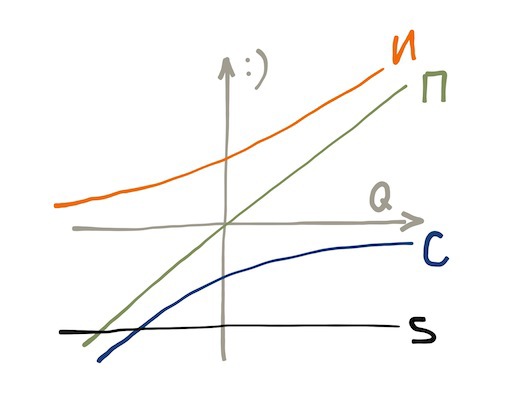
Hmm ... Something is not very simple yet, we need an explanation.
This thing is a Kano model. It is used, for example, in situations where it is necessary to understand whether the quality of the X function should be enhanced - or it is better to create a new Y function with the same resources. In the development of software and interfaces to it, is a very useful thing.
A letter is, of course, not software and not very much an interface. But this is definitely part of your IT service (or even an IT product). This means that Kano is quite capable of modeling.
Let's finally read this tricky scheme.
All functionality modeled by Kano is divided into three large groups.
Their scientific names are different, to hell with them. It is not the terms that are important to us, but the user's reaction to the fact of the presence / absence of functionality.
We apply these estimates to our three "white" types of mass mailings.
Now the meaning of axes is clear: the user’s happiness is vertical, the quality of implementation is horizontal.
“True” spam, of course, is always negative in terms of the user's level of happiness, how much quality is invested in it (and how many people deceive themselves that this affects the result). That is why spam emails are so creepy: and so it will come down, investing in the quality of the text and design usually does not give an increase in target indicators.
It becomes clear and something else.
Of course, the model will play with new colors exactly when you attach it to your business situation. But for the start and so it turned out well.
This was an article on how to respect users through mass mailings. How to move from the category of spammers willy-nilly to the category of businesses whose letters are read from beginning to end. What mistakes will lead to what results. And what to grab in the first place.
Everything will work out. Good luck!
Once again I remind you that the material is suitable for digestion only to people with sufficiently strong moral principles and a pronounced environmental awareness.
Why are some letters perceived by clients as spam, and others as useful reminders? What should be letters to help people buy? Which errors of mailing lists as a customer service are excusable, and which ones are fatal? Let's look at the cases and discuss the pros and cons of solutions.
Over the past few years, even the most highly motivated Internet businesses have moved from the policy “We will never send letters to our customers” to much calmer wording. Send as pretty - all or almost all.
From an economic point of view, this (for the time being) is beneficial to almost everyone: click on the button - send a text - get an increase in sales. Someone knows more "chips" - and counts the gold after each mailing. Someone figs as it may at random - but also usually does not mean nothing.
')
But harsh business laws cannot be fooled: if money comes out almost from the air (for now it is still like that), it means that some irreplaceable resource is being exploited in the process of being airborne.
What kind of resource is it, to whom does it belong, and is it worth exploiting it blindly?
There is an assumption (which is considered in this article) that this irreplaceable and mercilessly exploited resource is the emotional balance of users. Their gullibility and even naivety. Their readiness for communications. Their focus of attention. Their agreement to consume and digest information that catches the eye.
By itself, the exploitation of this resource is not such a black deed. This is known by whole crowds of offline personalities, from hitchhikers to MLM-traders in cosmetics, from sellers of newspapers in electric trains to street musicians.
Somewhere in this series are not too solid, but it’s not that shameful activities are worth e-mail marketing. And, as in all the above classes, in e-mail marketing, much depends on the mood in which a person comes in contact with you - and in which of them he leaves.
Managing customer emotions is part of customer service. So, when working with clients via e-mail, it would be good to know the rules for providing good service. Ideally, it would be nice to use them too.
It would seem that here it is time for us to move on to a conversation about "chips" and "receivers" that will help to position the user to us. Make a pink background in the letter - and immediately the girls melt, something like that.
But no, the notorious "chips" will not. First of all, the entire Internet is already full of them. Secondly, even the best “tricks” will only give the addressee a disservice if you don’t understand the main thing. And, thirdly, the core of your e-mail marketing would be, and the "tricks" are already easy to attach.
Let's focus on the main thing. Namely - on the problem that each of us deals with daily. And as a pro, and as a private person. Here it is, this problem:
People consider spam even letters that are sincerely written to make their lives easier.
Suppose you are writing an honest and open letter to a narrow group of your customers, inviting them to a free party with oysters and champagne - but they do not believe you. But you really conceived such a party! Something went wrong ... What?
Let's figure it out.
What is "considered spam"?
If you ask people what letters they consider spam, then we will hear something like the following:
- I work, and this garbage comes. Distracts!
- My mail is my castle. I did not call any advertisers in my personal space!
- Hell, plunged into the letter, spent a lot of time, but why?
- Yesterday they wrote, well, how much you can!
- Why should I read about how beautiful their company is?
- Boorish appeal, a letter with errors - yes, they ohreneli!
- Some kind of nonsense has been written, why do I need diapers?
- Enrages that I read them (at least the subject of the letter), but they will not hear me.
- Me, me put in one row with another million recipients?
- It is unpleasant that they rush me to make a decision.
- I don’t need it anymore, but they write everything ...
- The train left, before it was necessary to report!
- Why do they talk to me like I should something?
Perhaps the list can and continue. But let's stop on this for now. We breathe. Exhale And we understand that in this particular case, a person speaks not about objective reality, but about his emotions. Which means he's damn right!
Once again and slowly: the client has the right to emotions. And if he has already shown them - it means that one of the triggers of the negative reaction worked.
- The letter has become a distraction.
- The letter is perceived as an invasion of personal space.
- Sudden or complex content devours attention.
- Letters from one author is simply too much.
- Rejection of the self-position (selfishness) of the sender.
- Familiar and careless communication.
- The stupidity and clumsiness of the artificial mind.
- A game with only one goal, monologue instead of dialogue.
- Feeling "I'm faceless, I'm in a crowd."
- Gypsy - an attempt to press to force a decision.
- The letter is perceived as a "letter from the former."
- The letter was late, the train was gone.
- The letter is perceived as an attempt to manipulate.
Well, impressive? And now all this together - and the beggins, in front of us is a hefty such Dnieper, which not every bird will fly over.
Interestingly, the emotional evaluation of the letter occurs instantly. Perhaps in a split second. Only autistic engineers are trying to subtract and understand something there - normal people just explode with emotion and sentence your letter, and at the same time you are given a life ban.
Do you think about “chips” here?
Look to the user in the inbox.
We will conduct an experiment on living people - let's see what letters they, in fact, receive. Of course, we are only interested in mass and / or automatic mailings, and not personal correspondence.
Naturally, the average temperature in the hospital is rather difficult to calculate. To whom how much correspondence comes - it is a very individual matter.
However, to emotionally evaluate this correspondence, on the contrary, is quite easy. One has only to look from the point of view of the recipient - and everything becomes clear.
The fact is that with each individual letter the recipient must act in a certain way. These images, strictly speaking, are two.
- Do something right now. Go to the website, call, forward, etc.
- Something to do next. Read, buy, show his wife, etc.
That's all. Now or later. Yes, this is so simple.
And now there will be an ambush.
Which option do you think people usually prefer?
Yes, it was a trick question. Yes, it seems that all people are different and all have their own preferences. Yes, it all depends — it would seem — on the content of the letter. But no.
Sociologists have tormented and tormented and proved an interesting law, which (in a simplified, of course, variant) sounds like this:
If a person needs to choose between options A and B, he refuses to choose.
That is, you know what a thing, any - any! - the letter puts the person in a situation where he would prefer that this letter was not. No letter - no need to make a decision. In spam, in the basket, anywhere - the recipient is struggling with the fact of the existence of the letter, and not with its content. Many simply do not read mail - scary.
Yes, it seems like a small thing. But it seems to us so. For people who spend 5–10 minutes only to enter their mailbox, each letter twists its arms. And making a decision for them is painfully difficult.
And for people, on whom letters are falling hundreds per day, on the contrary, it is painfully easy to press the “In Spam” button. Just give a reason.
But I don’t give a reason, so what are they?
Look, we have already found out that everyone is absolutely everyone! - the letter is subject to the presumption of guilt. Either prove that you are a little dear, worthy of a decision on your case - either die, miserable, not callous eyes.
Let's classify the entire flow of what we have already seen in the Inbox. Exclusively from the point of view of the user and his interests. Different options are possible here, but we will limit ourselves to the classical 2x2 matrix and isolate 4 types of mass mailings.
- Service letters. The user does something (for example, is registered on the site), and he receives mail in the course of work.
- Information letters. Letters that the user does not mind reading, because in general he is interested (albeit somewhat passively) in their content.
- Push letters. The user began to do something, but interrupted. And, in general, I would like to continue (for example, use the service), but an external push is needed.
- Spam in its purest form. The user is not interested, not involved in the process and generally accidentally fell under the distribution.
That's all. It looks pretty simple too, right? Wait, everything is just beginning.
Scatter these four types on a 2x2 matrix and see what happens.

Vertically - the axis of engagement: whether the user remembers the context, tries to do something in connection with the main topic of the letter, is ready to act right now.
Horizontal is the axis of speed: how fast is the user ready to act.
It doesn't get any simpler, but I remind you that our goal is to roll over (along with the recipient of the letter) beyond the emotional threshold “Yes, go to hell with your spam!”.
And to smooth this threshold, you can, in fact, only in one way: send letters that the user recognizes and perceives as simplifying (and not complicating) the decision.
But user decisions are laid out in the same 2x2 matrix: do I want to do something and am I ready to do it right now. For the same matrix!
Wait, so what's coming out? A simple thing comes out: if the user is in the same state that the letter relies on, then the letter is perceived not as spam, but as a service! As part of the service. Like a hint. Like a cheat sheet. As a crutch when making a decision. In short, as a useful thing.
And so you do not give a reason?
And let's face it again. Simple and understandable truth.
When we looked at the inbox ...
Stop, after all you considered it too? Half a thousand letters will be enough to figure it out on your own. Do not be lazy, please, but it will turn out that you believe me on the word where it suits.
So, when we looked at the Inbox, we classified the letters from the user's point of view. And this is not at all the same as classifying them from the point of view of the sender.
It is clear that senders, consciously or intuitively, seek to mask one type of letters under another - from their point of view, it is easier to pass an emotional spam threshold. But as a result of this attempt to “cut off the corner” both the business and the clients receive such a bouquet from deception, self-deception and manipulation, from which the threshold only catastrophically increases.
We formulate it easier:
Spam is a subjective concept: the client considers spam everything that does not help him to make a decision in his particular situation.
Masking one type of letters under another increases the spam threshold for a particular letter (and reduces the service-orientation of the business as a whole). That is why, by the way, decent companies are very, very cautious with mass mailings: in the event of an error, a blow hits not the letter, but the brand.
It is clear that a service-oriented company is simply forced to take care not to disguise information letters as service ones, and service ones - under pushing ones. And it certainly can’t undergo all pure masks under all “decent” masks.
Sleight of hand and self-deception
Now analyze all kinds of camouflage. And we will understand how dangerous they are - or, on the contrary, are forgivable.
Service → Information

This shift usually happens with conference organizers. A completely normal story, if not for one “but”: mailing lists under the guise of information are usually written in a hurry, and they are often full of unpleasant errors.

If you got involved in this venture, first instruct the corrector to read the letter, and only then send it. Take your time, otherwise you will have time.
Service → Pushing

The easiest way to turn a service list into a push list is to send a statistical report. There is nothing bad, a normal move, but some may be frightened (numbers generally frighten people, especially if it is easy to see through them the quality — or “quality” —- their work).

Of course, the same people mastered the method the best, who knows a lot about gamification. Rush to do something right now to improve the performance of your favorite toys - a terrible force.
Information → Pushing

“Fly Alfa Bank airplanes!” I will fly, thank you. But, in general, I can’t take any concrete actions right now, no matter how I want Alfa-Bank and even myself.

Attempting to make a push out of an information letter usually looks pathetic. It is here that all the authors of the "selling texts" and other urban madmen graze. It is in these ezines cool brands lose their gloss and self-esteem. The reason is clear: marketers are not used to waiting; they urgently need to get beautiful numbers for a report. Unpleasant mistake.
Nudging → utility

Nice try, Bookmate. And I would even believe that this is a service list, but the trouble is that all other work with friends is disgusting. That is, I don’t have any benefit from this message - only Bookmate himself benefits from the follow your library.

A rather unpleasant phenomenon. It is only softening that usually you can still unsubscribe from such pseudo-service letters.
Pushing → Information

Twitter pretends to send a summary of recent events and interesting posts. In fact, of course, he is trying with all his might to translate a passive user into an active one.

The method itself is more than OK, but there is a danger of overdoing it. Every day to send this - just a little bust.
•••
Are there any hybrids without a dominant? Yes, easily.
Push + Service

The idea, along with the message of official information, to sell something to a knowingly loyal customer comes to mind. In general, there is almost no trouble in this, if it were not for one “but”: usually the question “What to offer?” Is relegated to artificial reason. And he is glad to try to offer a bearded admin a bikini swimsuit - simply because a year ago he bought something similar to his (former) wife.
So here is more accurate with the implementation. And of course, the service information should be clearly separated from the advertising (yes, we all love Rostelecom’s account stuffed with advertising, but this is already an offline story).
•••
Belief in the effectiveness of hybrids is indestructible. But in reality, it is most likely a myth and self-deception - it is almost unbearably difficult for the recipient to do two actions. However, you need to investigate the issue.
And talk separately about pure spam.
Pure spam is, in general, imposed communication. The user passed by, did not want anything, did not betray anything - and suddenly they made you happy.

It is clear that spam is trying to disguise itself as any of the three “white” types of letters. But for me, by the way, it was a surprise that mostly spam mimics under pushing letters.
Which, by the way, is the most disgusting of all the options: pushing letters rely on some remaining off-screen context and continue the conversation with the user. And to continue the conversation, which was not, is either a manipulation (the question “Buy?” Is replaced by “Buy now or later?” Or even “What exactly to buy?”), Or insanity.
You can sympathize with madness, but manipulation with us is not a matter of jurisdiction. But if suddenly a sacramental “What is that?” Sounds next to you, you know how to respond.
Mass Delivery Service Model
Suppose we successfully learned to pass the emotional spam threshold. And now you are faced with the coveted problem of the notorious "chips." And in fact - the problem of quality.
Do you invest in quality? Is mailing better and to what extent? Where does the balance of cost and economic efficiency lie along this path?
Let's look at another very simple scheme.

Hmm ... Something is not very simple yet, we need an explanation.
This thing is a Kano model. It is used, for example, in situations where it is necessary to understand whether the quality of the X function should be enhanced - or it is better to create a new Y function with the same resources. In the development of software and interfaces to it, is a very useful thing.
A letter is, of course, not software and not very much an interface. But this is definitely part of your IT service (or even an IT product). This means that Kano is quite capable of modeling.
Let's finally read this tricky scheme.
All functionality modeled by Kano is divided into three large groups.
- "Wow, class!"
- "Normally."
- "How is it not ?!"
Their scientific names are different, to hell with them. It is not the terms that are important to us, but the user's reaction to the fact of the presence / absence of functionality.
We apply these estimates to our three "white" types of mass mailings.
- “Wow, class!” Are newsletters. Good and nothing but good.
- “Normally” is nudging letters. Well, OK, thanks for reminding me, I’ll go to your site, I’ll go, I’ll go.
- “How is it not ?!” - this is a service reminder. How is it that you do not recover your password in the mail ?!
Now the meaning of axes is clear: the user’s happiness is vertical, the quality of implementation is horizontal.
“True” spam, of course, is always negative in terms of the user's level of happiness, how much quality is invested in it (and how many people deceive themselves that this affects the result). That is why spam emails are so creepy: and so it will come down, investing in the quality of the text and design usually does not give an increase in target indicators.
It becomes clear and something else.
- Newsletters are the most valuable to customers. And the most, unfortunately, laborious in implementation. But if there is at least some chance that users value them, develop your purely newsletters. Then I refer to the content marketing ideology that is useful for the development of customer service.
- Push emails are the easiest ROI to count. How much quality has invested - so much result and received. It is not surprising that it is the bullying newsletters that are the most (and it is easier to measure them).
- Service mailing if something and shine, then perhaps that their absence. Therefore, in general, they are doing something somehow: after a certain (very low) threshold, all further investments in quality begin to justify themselves very, very slowly, and this attracts very few people.
Of course, the model will play with new colors exactly when you attach it to your business situation. But for the start and so it turned out well.
And what?
This was an article on how to respect users through mass mailings. How to move from the category of spammers willy-nilly to the category of businesses whose letters are read from beginning to end. What mistakes will lead to what results. And what to grab in the first place.
Everything will work out. Good luck!
Once again I remind you that the material is suitable for digestion only to people with sufficiently strong moral principles and a pronounced environmental awareness.
Source: https://habr.com/ru/post/230769/
All Articles